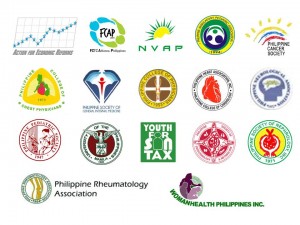
A Joint Press Statement
by 24 Health, Medical and Youth Organizations
March 17, 2014
We, the civil society coalition that supported the passage of the Sin Tax Law (R.A. 10351), wish to supplement and reinforce the statement of Department of Health (DOH) Secretary Enrique Ona regarding the law’s health impact. In a Congressional Oversight Committee hearing, Sec. Ona stated that it is still “too early to determine the public health impact of R.A. 10351”, as the periodical Global Adult Tobacco Survey (GATS) is scheduled to be conducted this year. We are glad to observe, however, the concrete gains in 2013 towards achieving the sin tax law’s health objectives, particularly for tobacco consumption. We continue to look forward to new information on the sin tax’s effect on smoking, such as the upcoming 2013 National Nutrition and Health Survey and the 2014 GATS. We note that during the same committee hearing, Finance Undersecretary Jeremias Paul reported that cigarette volume removals from tobacco manufacturing plant throughout 2013 declined by 15.5 percent to 4.9 million packs from 5.8 million in 2012. As National Tobacco Administration head Edgardo Zaragoza himself affirmed during that hearing: “The best indicator as to the consumption of cigarettes will be the removals, because that will be the demand side.” This national trend has also been reflected in local tobacco demand studies. A rapid tobacco survey conducted last December 2013 by DOH’s National Epidemiological Center (DOH-NEC) and AER found that weekly cigarette consumption among 304 Cotabato City smokers decreased by 34 sticks on average. Of those interviewed, 45 percent reduced smoking, and two percent quit completely. A similar study by AER in Angono, Rizal province likewise demonstrated that smokers reduced average weekly consumption by 10 sticks. Among the 418 smokers surveyed, 33 percent lessened tobacco use and eight percent stopped smoking altogether. Most recently, based on the 2013 Youth Adult and Fertility and Sexuality Study (YAFS) by the University of the Philippines’ Population Institute and Demographic Research & Development Foundation, smoking prevalence among young Filipinos aged 15 to 24 years old dropped from 21.9 percent in 2002 to 19.7 percent in 2013. According to the YAFS researchers, the rise in cigarette prices brought about by higher sin taxes was one of the primary reasons why a slight reduction in youth smoking prevalence has occured. In the light of these indicators, we confidently uphold our assessment that the sin tax law is proving itself to be an effective smoking reduction measure. With higher cigarette prices, long-addicted Filipino tobacco users are lessening their consumption, while would-be smokers, especially from the young and the poor, are increasingly discouraged from taking up smoking in the first place. Ironically, these gains for public health would have been even greater had tobacco industry players like Philip Morris Fortune Tobacco Corp. (PMFTC) and their political allies not lobbied intensively against a unitary sin tax scheme for cigarettes. We, as public health advocates, supported the government position to move at the soonest possible time for a unitary tax rate of PHP30 on all cigarettes, to prevent downshifting consumption among Filipino smokers. Our coalition now looks forward to the adoption of this unitary tax rate for tobacco products in 2017. If the evidence shows that smoking consumption has decreased last 2013, this unitary system will reap bigger gains for health, saving millions of smokers’ lives in the process. It is thus the duty of our legislators to promote the interest of these millions of Filipinos by heightening— not reversing— the health gains already introduced by the sin tax law in 2013. In the years to come, even greater gains from R.A. 10351 will be made available for all our countrymen: to uphold them will be a true victory for the Filipino people. SIGNATORIES:- Action for Economic Reforms (AER)
- FCTC Alliance of the Philippines (FCAP)
- New Vois Association of the Philippines (NVAP)
- Philippine Ambulatory Pediatrics Association (PAPA)
- Philippine Cancer Society (PCS)
- Philippine College of Chest Physicians (PCCP)
- Philippine College of General Internal Medicine (PSGIM)
- Philippine College of Physicians (PCP)
- Philippine Heart Association (PHA)
- Philippine Neurological Association (PNA)
- Philippine Pediatric Society (PPS)
- Philippine Rheumatology Association (PRA)
- Philippine Society of Endocrinology and Metabolism (PSEM)
- Philippine Society of Nephrology (PSN)
- University of the Philippines, Manila (UP Manila)
- WomanHealth Philippines (WomanHealth)
- Youth for Sin Tax Coaltion (YFST)
- UP Economics Towards Social Consciousness
- PLM College of Management and Entrepreneurship
- UP Buklod CSSP
- UP Strength in AIT
- UPLB Katipunan-CHE
- Akbayan Youth
- UP Buklod Isip
